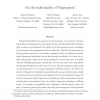Free Online Productivity Tools
i2Speak
i2Symbol
i2OCR
iTex2Img
iWeb2Print
iWeb2Shot
i2Type
iPdf2Split
iPdf2Merge
i2Bopomofo
i2Arabic
i2Style
i2Image
i2PDF
iLatex2Rtf
Sci2ools
110
click to vote
PAMI
2002
2002
On the Individuality of Fingerprints
Fingerprint identification is based on two basic premises: (i) persistence: the basic characteristics of fingerprints do not change with time; and (ii) individuality: the fingerprint is unique to an individual. The validity of the first premise has been established by the anatomy and morphogenesis of friction ridge skin. While the second premise has been generally accepted to be true based on empirical results, the underlying scientific basis of fingerprint individuality has not been formally established. As a result, the validity of fingerprint evidence is now being challenged in several court cases. A scientific basis for establishing fingerprint individuality will not only result in the admissibility of fingerprint identification in the courts of law but will also establish an upper bound on the performance of an automatic fingerprint verification system. We address the problem of fingerprint individuality by quantifying the amount of information available in minutiae features to e...
Related Content
| Added | 23 Dec 2010 |
| Updated | 23 Dec 2010 |
| Type | Journal |
| Year | 2002 |
| Where | PAMI |
| Authors | Sharath Pankanti, Salil Prabhakar, Anil K. Jain |
Comments (0)

